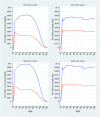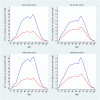Cost-utility and cost-benefit analysis of pediatric PCV programs in Egypt
- PMID: 36070504
- PMCID: PMC9746463
- DOI: 10.1080/21645515.2022.2114252
Cost-utility and cost-benefit analysis of pediatric PCV programs in Egypt
Abstract
New vaccine introductions (NVIs) raise issues of value for money (VfM) for self-financing middle-income countries like Egypt. We evaluate a pediatric pneumococcal conjugate vaccine (PCV) NVI in Egypt from health payer and societal perspectives, using cost-utility and cost-benefit analysis (CUA, CBA). We evaluate vaccinating 100 successive birth cohorts with the 13-valent PCV ("PCV13") and the 10-valent PCV ("PCV10") relative to no vaccination and each other. We quantify health effects with a disease incidence projection model and a multiple-cohort static disease model. Our CBA uses a health-augmented lifecycle model to generate willingness-to-pay for health gains from which we calculate rates of return (RoR). We obtain parameters from the published literature. We perform deterministic and probabilistic sensitivity analysis. Our base-case CUA finds incremental cost-effectiveness ratios (ICERs) for PCV13 and PCV10 relative to no program of $926 (95% confidence interval $512-$1,735) and $1,984 ($1,186-$3,805) per quality-adjusted life year (QALY), respectively; and for PCV13 relative to PCV10 of $174 ($88-$331) per QALY. Our base-case CBA finds RoRs to PCV13 and PCV10 relative to no program of 488% (188-993%) and 164% (33-336%), respectively, and to PCV13 relative to PCV10 of 3109% (1410-6602%). Both CUA and CBA find PCV13 to be good VfM relative to PCV10.
Keywords: Egypt; Pneumococcal conjugate vaccine; cost-benefit analysis; economic evaluation; invasive pneumococcal disease; otitis media; pneumococcal disease; pneumonia; rate of return; vaccines.
Conflict of interest statement
This study was led by Data for Decisions LLC (DfD) with funding from Pfizer Inc. JP Sevilla and Daria Burnes are employees of DfD and in that capacity have worked on this and other studies funded by grants from Pfizer and GSK to DfD. David Bloom is an external consultant to DfD and in that capacity has worked on this and other studies funded by grants from Pfizer and GSK to DfD. JP Sevilla and David Bloom in their personal capacities have received compensation from Pfizer and GSK for providing consulting services and for speaking and participating in meetings and advisory boards. Johnna Perdrizet, Sarah Pugh and Matt Wasserman are employees of Pfizer Inc. Rehab Zakaria El Saie is an employee of Pfizer Egypt. Hammam Haridy is an employee of Pfizer Gulf. Johnna Perdrizet, Sarah Pugh, Matt Wasserman, Rehab Zakaria El Saie, and Hammam Haridy held Pfizer stock or stock options at the time of the study. Pfizer Inc. employs Johnna Perdrizet, Sarah Pugh, Matt Wasserman, Rehab Zakaria El Saie, and Hammam Haridy, but otherwise played no role in study design, data collection and analysis, decision to publish, or preparation of the article.
Figures









Similar articles
-
Cost-effectiveness analysis of infant universal routine pneumococcal vaccination in Malaysia and Hong Kong.Hum Vaccin Immunother. 2016;12(2):403-16. doi: 10.1080/21645515.2015.1067351. Hum Vaccin Immunother. 2016. PMID: 26451658 Free PMC article.
-
An updated cost-effectiveness analysis of pneumococcal conjugate vaccine among children in Thailand.Vaccine. 2019 Jul 26;37(32):4551-4560. doi: 10.1016/j.vaccine.2019.06.015. Epub 2019 Jul 4. Vaccine. 2019. PMID: 31280944
-
Cost-effectiveness of 2 + 1 dosing of 13-valent and 10-valent pneumococcal conjugate vaccines in Canada.BMC Infect Dis. 2012 Apr 24;12:101. doi: 10.1186/1471-2334-12-101. BMC Infect Dis. 2012. PMID: 22530841 Free PMC article.
-
The impact of routine childhood immunization with higher-valent pneumococcal conjugate vaccines on antimicrobial-resistant pneumococcal diseases and carriage: a systematic literature review.Expert Rev Vaccines. 2019 Oct;18(10):1069-1089. doi: 10.1080/14760584.2019.1676155. Epub 2019 Oct 22. Expert Rev Vaccines. 2019. PMID: 31585049
-
Cost Effectiveness of Elderly Pneumococcal Vaccination in Presence of Higher-Valent Pneumococcal Conjugate Childhood Vaccination: Systematic Literature Review with Focus on Methods and Assumptions.Pharmacoeconomics. 2019 Sep;37(9):1093-1127. doi: 10.1007/s40273-019-00805-5. Pharmacoeconomics. 2019. PMID: 31025189
Cited by
-
Cost-Effectiveness Analysis of Pneumococcal Vaccines in the Pediatric Population: A Systematic Review.Healthcare (Basel). 2024 Sep 29;12(19):1950. doi: 10.3390/healthcare12191950. Healthcare (Basel). 2024. PMID: 39408130 Free PMC article. Review.
-
Bridging the gap in pneumonia prevention: Qualitative insights on vaccine implementation from health leaders in middle-income countries.PLOS Glob Public Health. 2025 Apr 23;5(4):e0004473. doi: 10.1371/journal.pgph.0004473. eCollection 2025. PLOS Glob Public Health. 2025. PMID: 40267080 Free PMC article.
References
-
- Troeger C, Blacker B, Khalil IA, Rao PC, Cao J, Zimsen SRM, Albertson SB, Deshpande A, Farag T, Abebe Z; Global Burden of Disease 2016 Lower Respiratory Infections Collaborators . Estimates of the global, regional, and national morbidity, mortality, and aetiologies of lower respiratory infections in 195 countries, 1990–2016: A systematic analysis for the Global Burden of Disease Study 2016. Lancet Infect Dis. 2018;18(11):1–22. doi:10.1016/S1473-3099(18)30310-4. - DOI - PMC - PubMed
-
- World Health Organization . Department of Immunization, Vaccines and Biologicals. Pneumococcal disease. Geneva (CH); 2014 Sep 29 [accessed 2020 Feb 18]. https://www.who.int/immunization/diseases/pneumococcal/en/.
-
- Wahl B, O’Brien KL, Greenbaum A, Majumder A, Liu L, Chu Y, Lukšić I, Nair H, McAllister DA, Campbell H, et al. Burden of Streptococcus pneumoniae and Haemophilus influenzae type b disease in children in the era of conjugate vaccines: global, regional, and national estimates for 2000–15. The Lancet Global Health. 2018;6(7):e744–57. doi:10.1016/S2214-109X(18)30247-X. - DOI - PMC - PubMed
-
- World Health Organization . Children: reducing mortality. Geneva (CH); 2019 Sep 19 [accessed 2020 Feb 18]. https://www.who.int/news-room/fact-sheets/detail/children-reducing-morta....
-
- World Health Organization. Global Action Plan . Monitoring evaluation & accountability. Secretariat annual report 2015. Geneva (CH): WHO Press; 2015.
MeSH terms
Substances
LinkOut - more resources
Full Text Sources
Medical
